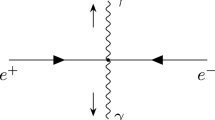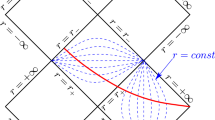Abstract
A spherically symmetric evolution model of self-gravitating matter with the equation of state p = −(1 + δ)ɛ (where δ = const) is considered. The equations of the model are written in the frame of reference co-moving with matter. A criterion for the existence and formation of a horizon is defined. Part of the Einstein equations is integrated analytically. The initial conditions and the constraints imposed on these conditions in the presence of a horizon are determined. For small δ, an analytic solution to spherically symmetric time-dependent Einstein equations is obtained. Conditions are determined under which the dynamics of matter changes from collapse to expansion. Characteristic times of the evolution of the system are evaluated. It is proved that the accretion of phantom matter (for δ > 0) onto a black hole leads to the decreases of the horizon radius of the black hole (i.e., the black hole is dissolved).
Similar content being viewed by others
References
M. Visser, Lorentzial Wormholes: From Einstein to Hawking (AIP, Woodbury, N.Y., 1996).
A. A. Shatskiĭ, Astron. Zh. 84, 99 (2007) [Astron. Rep. 51, 81 (2007)].
V. P. Frolov and I. D. Novikov, Black Hole Physics: Basic Concepts and New Developments (Kluwer, Dordrecht, 1998).
A. A. Shatskiĭ, Astron. Zh. 81, 579 (2004) [Astron. Rep. 48, 525 (2004)].
E. Babichev, V. Dokuchaev, and Y. Eroshenko, gr-qc/0507119.
A. R. Khabibullin, N. R. Khusnutdinov, and S. V. Sushkov, hep-th/0510232.
N. S. Kardashev, I. D. Novikov, and A. A. Shatskiĭ, Astron. Zh. 83, 675 (2006) [Astron. Rep. 50, 601 (2006)].
L. D. Landau and E. M. Lifshitz, Course of Theoretical Physics, Vol. 2: The Classical Theory of Fields, 7th ed. (Nauka, Moscow, 1988; Pergamon, Oxford, 1975).
M. Wyman, Phys. Rev. 75, 1930 (1949).
A. A. Shatskiĭ and A. Yu. Andreev, Zh. Éksp. Teor. Fiz. 116, 353 (1999) [JETP 89, 189 (1999)].
Author information
Authors and Affiliations
Additional information
Original Russian Text © A.A. Shatskii, 2007, published in Zhurnal Éksperimental’noĭ i Teoreticheskoĭ Fiziki, 2007, Vol. 131, No. 5, pp. 851–859.




